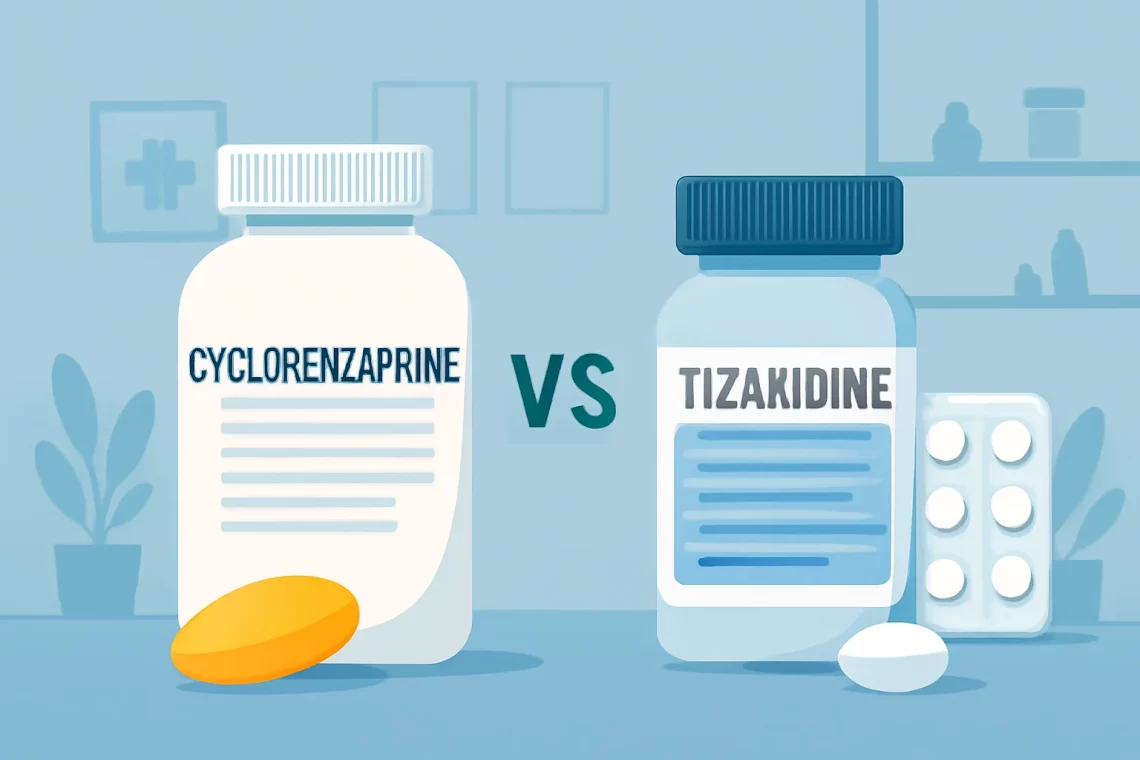-
Cyclobenzaprine vs Tizanidine: Key Differences and Uses Explained
Cyclobenzaprine and tizanidine are two medications commonly prescribed to manage muscle spasms and associated discomfort. Both belong to the category of muscle relaxants but differ significantly in their mechanisms of action, indications, and side effects. Understanding these differences is crucial for healthcare providers and patients alike, as it can influence treatment choices and outcomes. Cyclobenzaprine is primarily used for short-term relief of muscle spasms, often resulting from acute musculoskeletal conditions. It works by acting on the central nervous system, helping to reduce muscle tightness and discomfort. On the other hand, tizanidine operates differently by acting as an alpha-2 adrenergic agonist, which decreases spasticity by inhibiting the release of excitatory neurotransmitters.…
-
Cephalexin vs Doxycycline: Key Differences and Uses Explained
Cephalexin and doxycycline are both antibiotics that serve critical roles in the treatment of bacterial infections. They belong to different classes of antibiotics, which means they work in distinct ways and target various types of bacteria. Understanding their mechanisms, uses, and potential side effects can help patients make informed decisions when prescribed these medications. Antibiotics have been a cornerstone of modern medicine, providing essential treatments for infections that could otherwise be life-threatening. However, their effectiveness can depend on the specific type of bacteria causing the infection, as well as patient-specific factors such as age, health status, and potential drug interactions. This complex interplay highlights the importance of understanding the differences…
-
Benzonatate vs Codeine: Understanding Their Differences and Uses
Benzonatate and codeine are two medications commonly used to manage coughs, but they operate in distinctly different ways and have varying implications for patient care. Benzonatate is a non-narcotic cough suppressant that works by numbing the throat and lungs, reducing the urge to cough. On the other hand, codeine is an opioid that not only relieves cough but also serves as a pain reliever. Understanding the differences between these two medications is crucial for patients who may be considering their options for cough relief. Coughing can be a bothersome symptom caused by various conditions, including allergies, colds, and respiratory infections. Both benzonatate and codeine have their places in treatment protocols,…
-
Cyclobenzaprine vs Soma: Understanding Their Differences and Uses
Cyclobenzaprine and Soma are two medications commonly used for muscle relaxation and pain relief. Both drugs have become popular choices for individuals seeking relief from musculoskeletal conditions, but they differ in composition, mechanism of action, and potential side effects. Understanding these differences is crucial for patients and healthcare providers when determining the most appropriate treatment option. While cyclobenzaprine is often prescribed for short-term relief of muscle spasms, Soma, or carisoprodol, has its unique characteristics that set it apart. As healthcare continues to evolve, more individuals are seeking non-invasive solutions for muscle pain and spasms, leading to an increase in the use of these medications. However, the road to recovery can…
-
Azithromycin vs Levaquin: Key Differences and Uses Explained
Azithromycin and Levaquin are two widely used antibiotics that play a significant role in treating bacterial infections. The medical community often relies on these medications for their effectiveness against various pathogens. However, their mechanisms of action, spectrum of activity, side effects, and indications differ substantially. Understanding these differences is crucial for both healthcare professionals and patients, as the choice of antibiotic can greatly influence treatment outcomes. Both Azithromycin and Levaquin have unique characteristics that make them suitable for specific conditions. Azithromycin, a macrolide antibiotic, is known for its broad spectrum of activity, particularly against respiratory tract infections and certain sexually transmitted infections. On the other hand, Levaquin, a fluoroquinolone, is…
-
Amoxicillin vs Ceftin: Key Differences and Uses Explained
Amoxicillin and Ceftin are two commonly prescribed antibiotics that belong to the beta-lactam class of medications. Both are used to treat a variety of bacterial infections, but they differ in their specific applications, mechanisms of action, and side effects. Understanding these differences is crucial for both patients and healthcare providers when it comes to selecting the most appropriate treatment for a specific infection. As antibiotic resistance becomes a growing concern in healthcare, choosing the right antibiotic can significantly impact treatment outcomes and the overall health of individuals. The development and use of antibiotics have transformed medicine, allowing healthcare professionals to effectively manage infections that, in the past, could have been…
-
Naltrexone vs Naloxone: Understanding Their Differences and Uses
Naltrexone and naloxone are two medications that often come up in discussions surrounding addiction treatment and opioid overdose response. Both drugs belong to the class of opioid receptor antagonists, which means they work by blocking the effects of opioids in the brain. While they share some similarities, their uses, mechanisms, and effects differ significantly. Understanding the distinctions between naltrexone and naloxone is crucial for healthcare professionals, patients, and families affected by substance use disorders. The opioid epidemic has made the need for effective treatment options and emergency responses more urgent than ever. As communities strive to combat addiction and reduce the number of opioid-related deaths, these two medications play vital…
-
Cephalexin vs Augmentin: Key Differences and Uses Explained
The world of antibiotics is vast and complex, often leaving patients and healthcare professionals with challenging choices. Among the many antibiotics available, Cephalexin and Augmentin are two commonly prescribed medications. Both belong to different classes of antibiotics and are utilized to combat bacterial infections, but they differ significantly in their mechanisms, uses, and effectiveness. Understanding these differences is crucial for making informed decisions regarding treatment options. Cephalexin is a first-generation cephalosporin antibiotic, known for its efficacy against a variety of gram-positive bacteria. It works by disrupting the synthesis of the bacterial cell wall, ultimately leading to cell death. On the other hand, Augmentin is a combination antibiotic that contains amoxicillin…
-
Cyclobenzaprine vs Chlorzoxazone: Key Differences and Uses Explained
Cyclobenzaprine and chlorzoxazone are both medications commonly used to treat muscle spasms and discomfort. Although they serve similar purposes, these two drugs possess distinct properties, mechanisms of action, and side effects profiles. Understanding the nuances between cyclobenzaprine and chlorzoxazone can empower patients and healthcare providers to make informed decisions regarding treatment options. Muscle spasms can arise from various conditions, including injuries, overuse, or underlying medical issues. The sensation of tightness, pain, or restricted movement can significantly impact daily life, leading individuals to seek relief through medication. While both cyclobenzaprine and chlorzoxazone are classified as muscle relaxants, they differ in their chemical structure and how they interact with the nervous system.…
-
Ativan vs Valium: Understanding Their Differences and Uses
Ativan and Valium are two widely recognized medications that belong to the benzodiazepine class of drugs. Both are primarily used to treat anxiety and other related conditions, but they have different properties, indications, and effects on the body. As the prevalence of anxiety disorders continues to rise, understanding the distinctions between these two medications becomes increasingly important. Benzodiazepines work by enhancing the effects of a natural chemical in the body called gamma-aminobutyric acid (GABA). This action leads to a calming effect on the central nervous system, which can be beneficial for those experiencing anxiety, panic attacks, or sleep disorders. However, while both Ativan (lorazepam) and Valium (diazepam) serve similar purposes,…






































